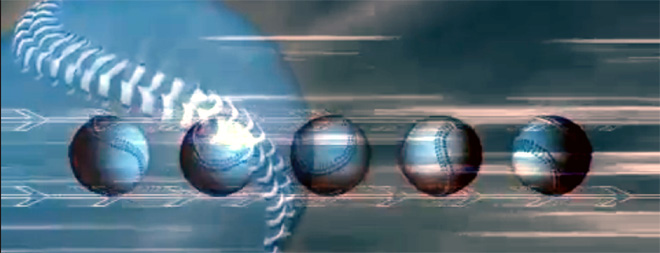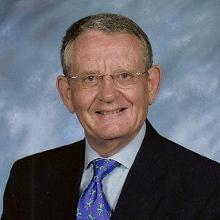Unraveling the Secrets of the Knuckleball

Researchers have found that an effect in the wake that the ball leaves behind it as it travels toward the batter creates the knuckling effect.
(Inside Science) -- A team of French researchers has examined what causes the knuckleball -- in baseball and other sports -- to move unpredictably late in flight. They conclude that the player who throws, kicks or otherwise releases the ball provides just one factor in the orb's resulting motion.
The finding is particularly relevant because Major League Baseball honored New York Mets pitcher R.A. Dickey with the 2012 National League Cy Young award. Dickey's stock in trade is the ability to throw the fluttering knuckleball pitch so accurately and consistently that he ended the season with 20 wins and an ERA of just 2.73.
The researchers have found that an effect in the wake that the ball leaves behind it as it travels toward the batter creates the knuckling effect, as long as the pitcher throws the ball at the appropriate speed.
"When a sphere is in a flow, there is a critical velocity at which the wake behind the sphere and the drag force acting on the ball sharply decrease," explained hydrodynamics graduate student Caroline Cohen of France's Ecole Polytechnique. The decrease in the size of the wake can lead to a sideways force that increases the ball’s deviation from a straight-line path. Fluid physicists call this the "drag crisis."
Thrown relatively slowly and with minimum spin, compared with that of Major League fastballs, the knuckleball confuses batters by changing direction in an apparently random fashion late in flight.
But knuckleballs aren't restricted to baseball. In cricket, Indian fast bowler Zaheer Khan has been known to use a knuckler for his slower ball. Volleyball players experience knuckling as a spiked ball closes on them. And, most important to the French scientists, top players such as Spanish league Real Madrid star Cristiano Ronaldo can kick a soccer ball in such a way that it zigzags unpredictably en route to an opposing goalkeeper.
Ronaldo's performances persuaded the group, headed by Ecole Polytechnique research director Christophe Clanet and also including his graduate student Baptiste Texier, to explore the effect.
To remove the human factor, they dropped steel, glass, and plastic beads of different sizes into a tank of water and monitored their passage with a high-speed camera.
"The advantage of water is in reducing the length of the observation, because water's density is 1,000 times that of air," Clanet explained. "Moreover, we can easily visualize the wake of the beads in water with a fluorescing dye."
To ensure that the beads were not spinning as they entered the water, the team drew two perpendicular lines on each bead. Images of the lines taken as the beads dropped confirmed that the beads did not twist or rotate once they reached the water.
"It's a very clever way to proceed -- creating a laboratory situation that, as best they can, models real life," said Alan Nathan, an emeritus professor of physics at the University of Illinois at Urbana-Champaign, who has used tracking images to analyze knuckleball pitches.
The study provided the surprising result that the extent of knuckling increased when they used less dense beads to pass through the water.
"The big surprise was that every bead made a zigzag -- from a little plastic bead to a steel one weighing seven kilograms," Cohen said. "Our visualizations showed that the zigzag effect is due to the asymmetry of the wake behind a sphere, caused by the rearrangement of the vortex the sphere emits as it flows through the water."
Based on their observations, the French team deduced a set of laws to predict the amount of knuckling for different ball sizes and fluids.
But an initial understanding of those laws, Cohen said, indicated that that we should be unable to observe the knuckle effect in soccer. Since Ronaldo undoubtedly knuckles a soccer ball, the process needed another ingredient.
That extra ingredient was the drag crisis.
"But you need to kick the ball at a velocity close to that of the drag crisis and to do so with no spin to observe the knuckle effect," Cohen said.
The make-up of the soccer ball also influences the extent of knuckling.
"The smoother the sphere, the more zigzag you observe, because the drag crisis is larger for smooth spheres," Cohen said.
The Jabulani soccer ball used in the 2010 Men's World Cup fluttered so much more than previous balls because it had no seams and was very smooth, she added.
But the construction of baseballs used by the MLB remains the same every season, so that factor doesn't affect knuckleball pitchers.
"The only difference in baseballs is the presence of seams, which can orient the direction of the lateral force," Cohen said. "But the effect is the same."
The research suggests why there are random changes in the ball's movement even if it is consistently released the same way.
"It could well be that the ultimate reason for the knuckleball is the shedding of vortices. That doesn't at all contradict what I have found by tracking pitches," Nathan said.
The research was presented earlier this month at a meeting of the American Physical Society's Division of Fluid Dynamics, in San Diego.

